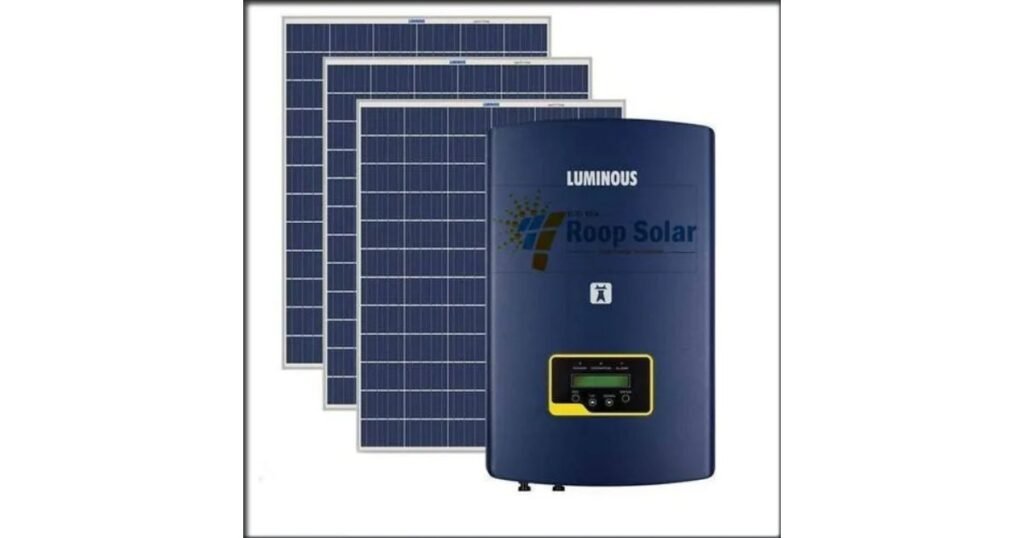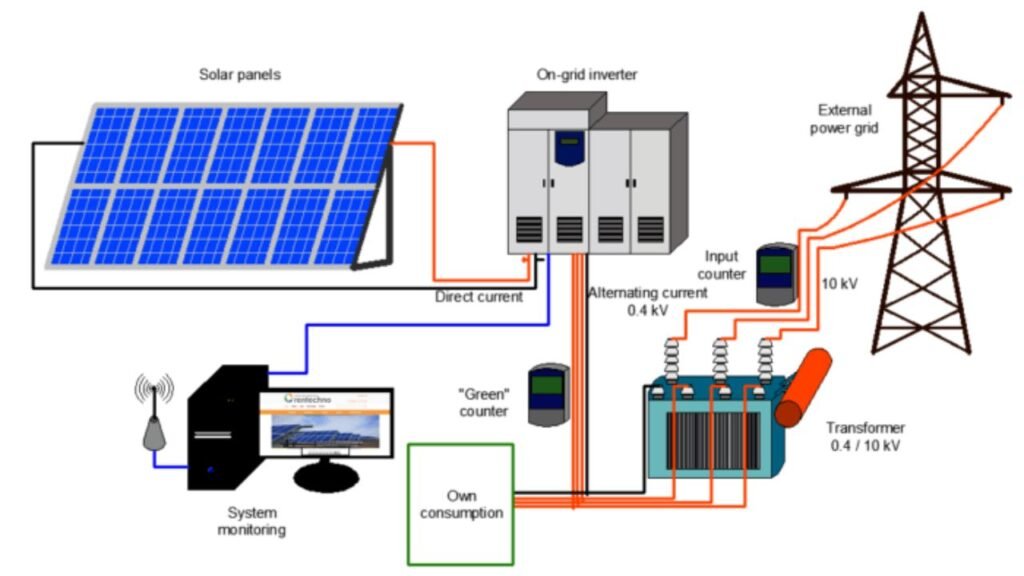An off grid solar system is an efficient and sustainable way to generate electricity independently of the local power grid. It ensures continuous energy supply even in remote areas and helps reduce electricity expenses. With growing adoption in India, more households and businesses are exploring solar solutions. In this guide, we will explain how an off-grid solar system operates, its essential components, advantages, sizing tips, cost factors, and the 3kw off grid solar system price in India.
What is an Off-Grid Solar System?
An off grid solar system is a standalone energy solution that works independently of the traditional electricity grid. It does not rely on local utility connections, making it perfect for remote locations and areas with frequent power outages. This system allows homes and businesses to generate, store, and use electricity on their own.
Off-grid solar systems are gaining popularity in India due to their ability to provide reliable power. They ensure energy autonomy and reduce dependence on expensive electricity. Users can enjoy continuous power supply, even during blackouts or grid failures.
How an Off-Grid Solar System Operates?
An off grid solar system works by converting sunlight into electricity. Solar panels capture sunlight and convert it into direct current (DC) electricity. A charge controller manages the flow of electricity into batteries. The stored DC power is then converted into alternating current (AC) by an inverter, making it suitable for household appliances.
The system provides power even when the sun is not shining. Proper design ensures that energy storage is sufficient for night use and cloudy days. Users get consistent energy without relying on the grid.
Essential Components of an Off-Grid Solar System
An off grid solar system has key components that capture, store, and supply energy. These include solar panels, charge controllers, batteries, and inverters. Each component plays a critical role in system efficiency and reliability.
1. Solar Panels and Their Types
Solar panels, or photovoltaic (PV) panels, capture sunlight and convert it into electricity. They are the core of any solar system.
There are three main types of solar panels:
- Monocrystalline: High efficiency and long-lasting, ideal for small spaces.
- Polycrystalline: Budget-friendly with moderate efficiency.
- Thin-Film: Less efficient, suitable for large installations.
Panels can be roof-mounted or ground-mounted. Roof-mounted panels save space, while ground-mounted panels are suitable for larger areas.
2. Charge Controllers
A charge controller regulates the flow of electricity from solar panels to batteries. It prevents overcharging and extends battery life. This ensures safety and maintains consistent energy storage for off-grid systems.
3. Battery Storage Options
Batteries store excess solar energy for use during nights or cloudy days. They are essential for system reliability. There are several types of batteries for off-grid systems:
| Battery Type | Advantages | Disadvantages |
| Lithium Batteries | Long lifespan, low maintenance, safe | High upfront cost |
| Flooded Lead Acid | Affordable, simple to install | Requires regular maintenance |
| AGM Lead Acid | Maintenance-free, reliable | Shorter lifespan than lithium |
The right battery depends on energy requirements and budget. Lithium batteries cost more initially but offer long-term savings.
4. Inverters and Their Function
The inverter converts DC power stored in batteries into AC power. This AC power is compatible with household appliances. Choosing a high-quality inverter ensures efficient energy conversion and system durability.
Off-Grid vs Grid-Tied Solar Systems
Understanding the difference between off-grid and grid-tied systems helps in making informed decisions. Both systems have advantages depending on energy needs and location.
Benefits of Off-Grid Solar Systems
- Complete independence from the electricity grid. Users generate and use their own power.
- Reliable power in remote areas without access to the utility grid.
- No monthly electricity bills, providing long-term savings.
- Suitable for homes and businesses aiming for energy autonomy.
Benefits of Grid-Tied Solar Systems
- Lower initial cost as no batteries are required.
- Excess electricity can be sold back to the grid, reducing bills.
- Access to electricity even if solar panels are not producing enough power.
Key Difference: Off-grid systems provide complete energy independence, while grid-tied systems rely partially on the utility grid.
Choosing the Right Size for an Off-Grid Solar System
Sizing an off grid solar system requires understanding energy consumption, sunlight availability, and budget. Correct sizing ensures efficient and uninterrupted power.
- Calculate Daily Energy Needs: Add up the wattage of all appliances and their usage time.
- Determine Solar Panel Output: Divide daily energy requirement by peak sunlight hours.
- Select Battery Capacity: Ensure batteries can store enough power for non-sunny days.
- Budget Consideration: Larger systems provide more energy but cost more. Balance requirements and affordability.
A 3 kW off-grid solar system is ideal for small households. Users should consider energy efficiency and storage needs when planning their system.
Cost of Off-Grid Solar Systems in India

The 3kw off grid solar system price in India varies based on components, installation, and battery type. It is an investment that pays off over time through reduced electricity bills.
| Component | Estimated Cost (INR) |
| 3 kW Solar Panels | ₹1,50,000 – ₹2,00,000 |
| Inverter with Charge Controller | ₹50,000 – ₹70,000 |
| Battery Storage (10–20 kWh) | ₹1,50,000 – ₹3,00,000 |
| Installation & Labor | ₹30,000 – ₹50,000 |
The total cost of a 3 kW off-grid solar system ranges from ₹3,50,000 to ₹4,50,000. Choosing lithium batteries may increase costs but ensures longer lifespan and efficiency.
Factors Influencing Off-Grid Solar System Costs
The cost of an off-grid solar system is influenced by several key factors. The type of battery used plays a major role, as lithium batteries are more expensive but provide a longer lifespan and better efficiency. System size also affects the cost since larger systems require more solar panels and batteries, increasing the overall investment. Installation complexity, such as choosing between roof-mounted or ground-mounted setups, can add to labor and material expenses.
Additionally, the quality of components, including panels and inverters, impacts performance, maintenance requirements, and durability. By carefully selecting the right combination of battery type, system size, installation method, and component quality, users can ensure optimal energy production and long-term cost efficiency.
Tips for Maximizing Off-Grid Solar System Efficiency
Following these tips ensures consistent energy supply and maximum system output.
- Position panels where they receive maximum sunlight.
- Use energy-efficient appliances to reduce consumption.
- Maintain batteries and panels regularly for longer life.
- Monitor energy usage to optimize storage and prevent wastage.
Why Off-Grid Solar Systems Are Ideal for India?
India has high solar potential, especially in rural and remote regions. Off grid solar systems provide reliable energy where the electricity grid is unstable or absent. They also reduce dependence on diesel generators, lowering energy costs and emissions. These systems are suitable for households, farms, and businesses looking to reduce electricity bills and switch to sustainable energy. With government incentives, adopting solar energy has become even more feasible.
Conclusion:
An off grid solar system is a smart solution for energy independence and sustainability. It offers uninterrupted power, long-term savings, and environmental benefits. The 3kw off grid solar system price in India may vary, but careful planning ensures affordability and efficiency. Investing in an off-grid solar system allows users to control their energy, reduce reliance on electricity grids, and enjoy consistent power. It is a future-ready choice for homes and busines.
Also Read About: 5kW Solar System Price in India (2025): Complete Cost, Subsidy, and Benefits
